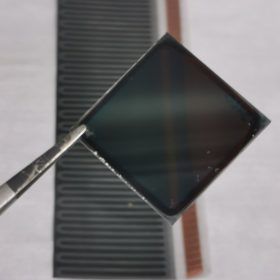
An international research team led by Belgian research institute Imec achieved the result with a flexible thin-film cell for BIPV applications with a surface of approximately 1cm². The new result is an improvement of the 24.6% efficiency the consortium announced in September 2018. The cell's creators said they are now aiming for a 30% efficiency.
Scientists from Belgium’s Hasselt University, Belgian research institutes Imec and Vito, and the Percistand consortium, which includes other entities such as EnergyVille and Solliance, claim to have been the first in achieving a 25% efficiency for a flexible thin-film solar cell for BIPV applications. “With these thin-film solar cells, we are truly competitive with the traditional solar panel sector for the first time,” said Imec’s researcher Bart Vermang.
The research team said it utilized two types of materials laid on the top of each other to achieve this record efficiency. “In recent weeks we’ve combined the best bottom and top cells, which is how we have already achieved this high efficiency level of 25 percent,” the researchers stated, without providing further details on the cell technology. It only specified that the two-layer cell is based on a thin wafer, and that is has a surface of 1cm². It remains unclear if the result was certified by an independent entity.
The scientists added they are still seeking to find a cost-efficient way to combine the two layers together, but they quite optimistic about reaching a 30% efficiency in the years to come. “We’ll definitely get there,” said Vermang in a statement released.
The result is an improvement of the 24.6% efficiency that the same group announced in September 2018 for a tandem CIGS solar cell based on perovskite, Imec’s press office told pv magazine. That 0.5cm² cell was made with a perovskite cell combined with a CIGS cell, developed by Germany’s Centre for Solar Energy and Hydrogen Research (ZSW).
In September, the ZSW, CIGS module manufacturer Nice Solar Energy and the Karlsruhe Institute of Technology (KIT) announced a plan to design tandem PV modules based on CIGS and perovskite, which they say can theoretically achieve efficiencies well above 30%.
“We are developing the next generation of highly efficient thin-film tandem solar modules with an efficiency of more than 30%,” said Ulrich W Paetzold, junior research group leader at KIT at the time. “Promising fields of application are, for example, highly efficient solar modules for building-integrated photovoltaic [BIPV] solutions.”
In January 2019, Solliance announced a 21.5% efficiency for a cell relying on two thin film PV technologies combined into a single four terminal tandem solar cell stack. The CIGS cell, based on lightweight stainless-steel foil using a high throughput roll-to-cell sputtering process, was developed by U.S.-based PV thin film specialist MiaSolé Hi-Tech, a unit of the Hanergy Group.
Lắp đặt điện mặt trời Khải Minh Tech
https://ift.tt/2X7bF6x
0906633505
info.khaiminhtech@gmail.com
80/39 Trần Quang Diệu, Phường 14, Quận 3
Lắp đặt điện mặt trời Khải Minh Tech
https://ift.tt/2ZH4TRU
Không có nhận xét nào:
Đăng nhận xét